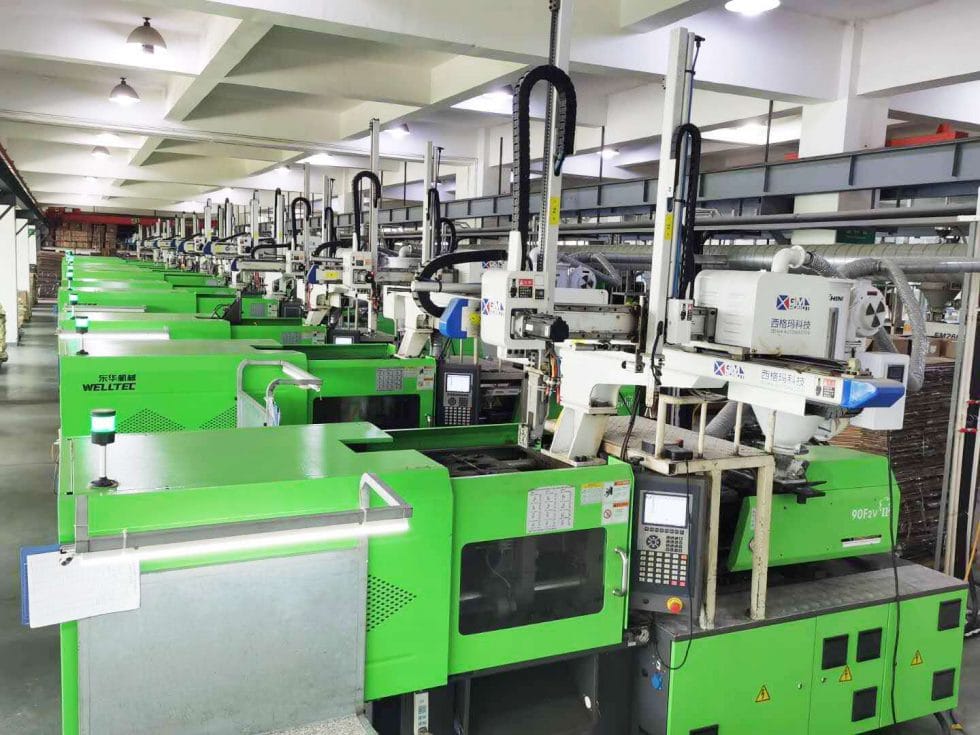Plastic Injection Molding: The Manufacturing & Design Guide

Plastic injection molding is a highly repeatable manufacturing process used to mass-produce identical plastic parts. It is ultimately a cost-efficient method of producing the plastics we use daily, such as bottle caps, toys, and appliance parts.
To begin the process, thermoplastic polymer granules are melted. These polymers, which can be colored or filled with other additives, are then injected under pressure into the mold. The liquid plastic cools and solidifies. Once solid, the mold opens and pushes the part out. Next, the mold closes, and the process is repeated.
This process produces consistent results within tight tolerances and offers manufacturers high levels of design freedom. Though there is a high initial investment in mold creation, the cost is recuperated in high-volume production runs.
Types of Injection Molding
Injection molding can be used to produce tiny parts like model airplane pieces or larger items such as car body panels. The process is primarily used when there is a need to produce thousands, or millions, of identical parts.
Common types of injection molding include:
- Blow Molding: Used in forming bottles and other plastic shapes, blow molding is accomplished by blowing compressed air into the mold.
- Over Molding: Also known as co-molding or two times injection molding, over-molding involves forming a mold out of one material and then partially or fully covering that mold in another material.
- Insert Molding: In insert molding, a non-plastic component is inserted into the mold where it is covered in plastic.
- Cube Molding: A molding process for the manufacture of circular parts, cube molding is characterized by components that rotate vertically around the axis.
Materials Used in Injection Molding
A wide variety of materials are used in plastic injection molding. Materials are selected based on their weight, strength, and resistance to certain environments (heat, acid, or moisture). Plastics can also be combined to create different properties and effects.
- ABS (Acrylonitrile Butadiene Styrene)
- ABS/PC (Acrylonitrile Butadiene Styrene + Polycarbonate)
- Acetal
- Acetal Copolymer
- Acetal Homopolymer
- ETPU (Expanded Thermoplastic Polyurethane)
- HDPE (High-Density Polyethylene Resin)
- LCP (Liquid Crystal Polymer)
- E (Low-Density Polyethylene Resin)
- LLDPE (Linear Low-Density Polyethylene Resin)
- Nylon 6
- Nylon 5/12
- PBT (Polybutylene Terephthalate)
- PC/PBT (Polycarbonate/Polybutylene Terephthalate)
- PEEK (Polyetheretherketone)
- PEI (Polyetherimide)
- PET (Polyethylene Terephthalate)
- PETG (Polyethylene Terephthalate Glycol)
- PMMA (Polymethyl Methacrylate Acrylic)
- Polycarbonate
- Polypropylene
- PPA (Polyphthalamide)
- PPE/PS (Polyphenylene Ether + Polystyrene)
- PS (Polystyrene)
Injection Molding Design Process
To achieve optimal end results, there are several factors to consider when planning your injection molding design. Considering the following factors can reduce the risk of defective or substandard final components:
- Materials: Each plastic material has different characteristics (elemental resistance, strength, cost) that must be considered. Resins also react differently when treated to heat during the molding process, and they have different features when cooled.
- Tolerances: Plastics can warp and shrink in the mold, so this needs to be factored into the design. The chemistry of each plastic also lends itself to different tolerances. For example, acrylics have low shrink rates and can hold tighter tolerances, but LDPE cannot withstand very high temperatures and easily warps.
- Mold Design: The mold itself needs to be carefully designed. Wall thickness should be uniform; elements like ribbing can help. Molds also require a certain amount of draft, so the part can be properly ejected. This is especially important in injection molding, as the high pressure allows one to inject plastic into all the small nooks and crannies of a mold, which can make the part hard to remove. Parts with intricate details will also need extra draft to keep the design intact.
- Shrinkage Rate: Different plastics shrink at different rates, due to differences in resin structure, the mold itself, and how the plastic flows into the mold. Injection pressure can improve the shrinkage rate, but different resins require different tonnages per square inch.
- Surface Finishing: There are 12 grades of plastic finishes according to the Society of Plastics, ranging from dull to shiny. Different finishing services are required for each type of shine – sandblasting produces a dull finish, and diamond polishing creates a mirror shine. One must also consider the plastic itself. For example, you cannot use powder coating on low-melt materials, but plastics like PVC can withstand high temperatures.
Benefits of Plastic Injection Molding
The main benefit of plastic injection molding is that it allows for the rapid manufacture of a large number of identical parts. After covering the initial mold-making cost, the production costs for injection-molded parts are low and continue to decrease as production runs increase.
A wide range of materials can be used in injection molding, and the process is highly repeatable. It produces finished parts with tolerances of ±0.500 down to ±0.125 that have excellent visual appearance and need little or no extra finishing.
Plastic injection molding produces minimal waste compared to other types of traditional manufacturing processes as no material is removed from the cured product.
Source International
The process-driven professionals at Source International can produce plastic molded injection products in a variety of shapes and sizes to suit many different industries. Our ISO 9001-certified facilities give us the capability to deliver a diverse set of parts using a variety of materials.
Providing plastic injection molded products for over 25 years, Source International offers reliable, accurate, and cost-effective plastic injection molding services. With cutting-edge capabilities, we can handle complex molds with core pins, multiple cavities, cams, and lifts for insert molding, over-molding, in-mold decoration, and in-mold assembly. Presses in the 50-ton to 3,300-ton range enable our professionals to create shot sizes as small as 5g to as large as 2,500g with tolerances of ±0.005.
Contact us today for more information.
